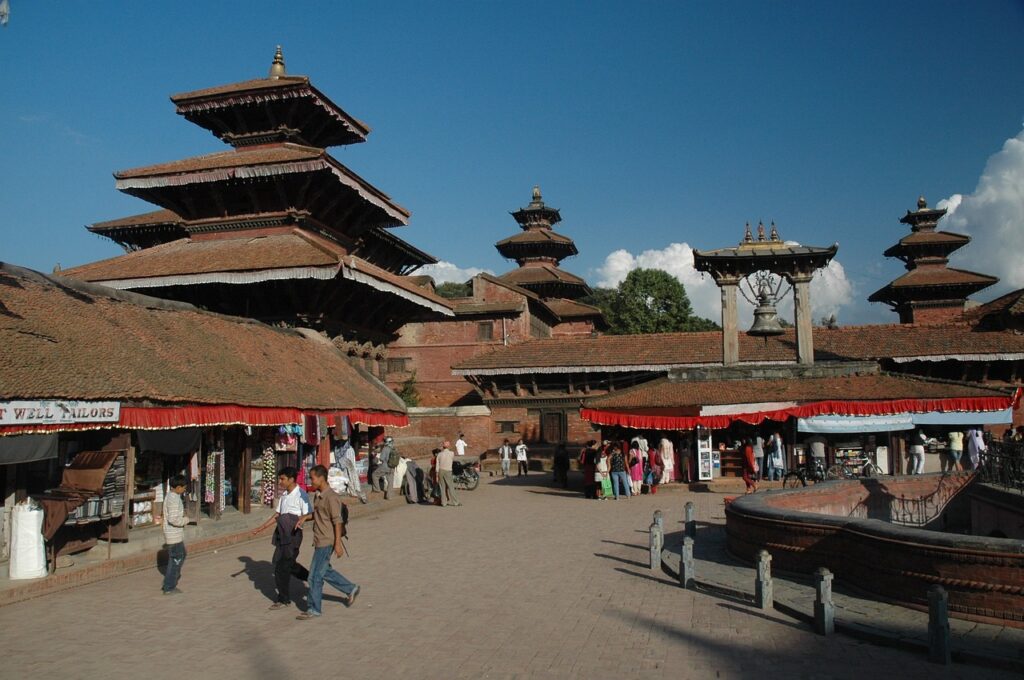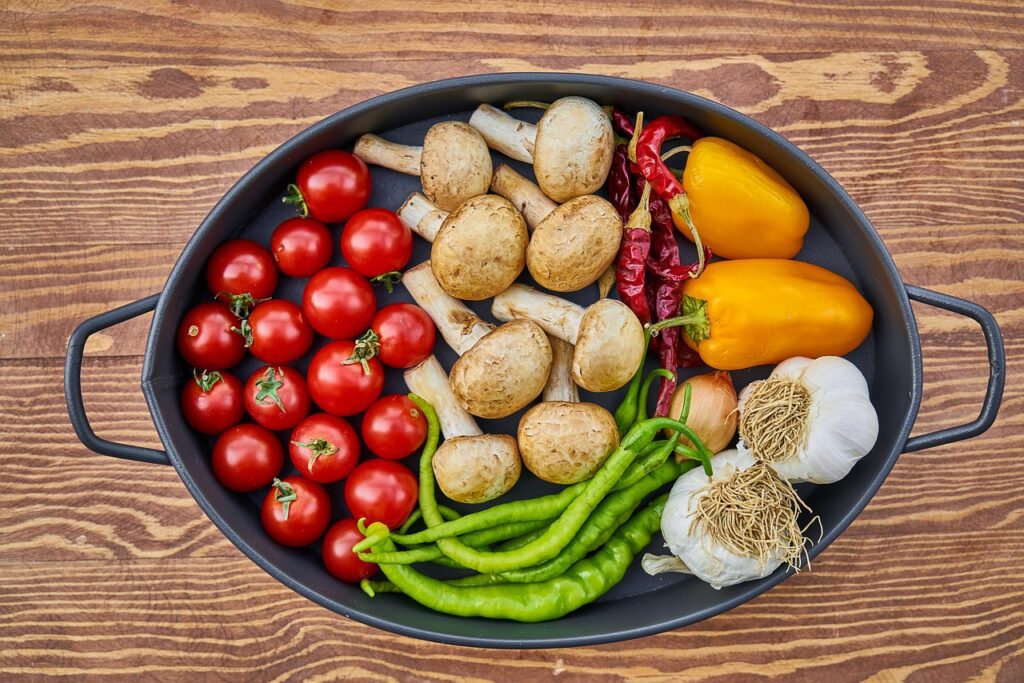Nepal boasts a rich tapestry of traditional foods, each reflecting the diversity of its culture, geography, and ethnic communities. Here are some other traditional foods that contribute to the vibrant culinary landscape of Nepal
1. Dhido:
Dhido is a traditional and staple food in many Nepali households, especially in the hilly and mountainous regions. It is made by continuously stirring buckwheat or millet flour in boiling water to form a dense, sticky, and dough-like consistency. Dhido is often served with accompaniments like Gundruk or pickles.
Process:
- Prepare the Flour Mixture: Mix buckwheat or millet flour with water to form a thick, lumpy batter.
- Boil Water: Bring water to a boil in a large pot.
- Pour the Mixture: Gradually pour the flour mixture into the boiling water while continuously stirring.
- Stir Constantly: Keep stirring vigorously to prevent lumps from forming.
- Form a Dough: As the mixture thickens, it will start to form a dense, sticky, and elastic dough.
- Serve: Dhido is traditionally served in small portions, and it’s common to eat it with various side dishes like Gundruk or pickles
Common Places: Dhido is a staple in many households across Nepal, especially in hilly and mountainous regions. It’s often consumed in rural areas and is part of the daily diet of people in these regions.
2. Kwati (Mixed Bean Soup):
Description: Kwati is a wholesome soup made from a mix of nine different types of sprouted beans. This dish is not only rich in protein but is also associated with festivals, especially during the Nepali New Year. Kwati is flavored with various spices and often enjoyed with a dollop of ghee.
Process:
- Soak the Beans: Soak a mixture of nine different types of beans overnight.
- Sprout the Beans: Allow the soaked beans to sprout by rinsing and draining them over a few days.
- Prepare the Soup Base: In a large pot, sauté onions, garlic, and ginger. Add spices like cumin, coriander, and turmeric.
- Add Beans: Add the sprouted beans to the pot and stir well.
- Cook: Pour enough water to cover the beans and simmer until the beans are tender.
- Serve: Kwati is traditionally served hot, often with a dollop of ghee on top.
Common Places: Kwati is popular across Nepal and is particularly associated with festivals, especially during the Nepali New Year. It is commonly prepared in homes, and you can find it in restaurants serving traditional Nepali cuisine.
3. Sukuti (Dried Meat):
Description: Sukuti is a traditional Nepali dried meat preparation. Typically made from buffalo or goat meat, it is marinated in various spices, sun-dried, and then grilled or fried. Sukuti is a popular snack, especially in the mountainous regions, and is known for its robust flavor and chewy texture.
Process:
- Choose the Meat: Select lean cuts of buffalo or goat meat.
- Marinate: Marinate the meat in a mixture of spices, including cumin, coriander, chili powder, salt, and sometimes garlic and ginger paste.
- Sun-Dry: Lay out the marinated meat in the sun to dry, preserving it naturally.
- Grill or Fry: Once dried, grill or fry the meat until it reaches a crispy texture.
- Slice and Serve: Sukuti is usually sliced into thin strips and served as a snack or added to various dishes for flavor.
Common Places: Sukuti is widely consumed in mountainous and hilly regions of Nepal, where the drying process is facilitated by the higher altitudes and dry climate. It’s often enjoyed as a snack in these areas.
4. Gundruk Ra Bhatmas (Fermented Leafy Greens with Soybeans):
Description: Similar to Gundruk, this dish involves fermenting leafy greens, usually mustard greens, along with soybeans. The combination of fermented greens and soybeans creates a unique flavor profile that is savory, slightly sour, and packed with umami. It is often enjoyed as a side dish with rice.
Process:
- Prepare Leafy Greens: Clean and shred mustard greens or other leafy greens.
- Add Soybeans: Mix the shredded greens with soybeans.
- Pack in a Jar: Pack the mixture tightly into a jar, adding salt for fermentation.
- Ferment: Let the mixture ferment for about a week.
- Sun-Dry: After fermentation, sun-dry the mixture for a day.
- Use as Side Dish: Gundruk Ra Bhatmas is used as a side dish, adding a unique fermented flavor to the meal.
Common Places: Gundruk is a common side dish throughout Nepal, but its consumption is more prevalent in hilly and mountainous regions. It’s often used in traditional Nepali meals, especially in rural communities.
5. Yak Cheese:
Description: Found in the high-altitude regions of Nepal, Yak cheese is a specialty with a distinct flavor. It is commonly used in various traditional dishes and snacks. The cheese is often consumed in its natural form or added to dishes like momos and Thukpa, enhancing their taste with its rich and slightly smoky notes.
Process:
- Milk Collection: Milk from yaks is collected, typically in high-altitude regions.
- Curd Formation: The milk is allowed to curdle, forming curds.
- Cheese Formation: The curds are pressed to extract the whey, and the remaining solid is left to age, forming Yak cheese.
- Curing: Yak cheese is cured for a specific period to develop its unique flavor.
- Usage: Yak cheese can be consumed on its own or used in various traditional dishes like momos or Thukpa.
Common Places: Yak cheese is primarily found in high-altitude regions, such as the Himalayan mountains. Places like the Annapurna and Everest regions are known for producing and using Yak cheese in various dishes.
6. Sel Roti (Rice Doughnut) – Variation:
Description: While Sel Roti was mentioned earlier, it’s worth noting that there are regional variations. In some areas, especially in the Terai region, rice flour doughnuts are prepared with different ingredients, adding unique local spices and flavors.
Process:
- Prepare the Batter: Mix rice flour, sugar, and milk to create a thick batter.
- Heat Oil: Heat oil in a deep pan for frying.
- Pour into Rings: Pour the batter in ring shapes into the hot oil.
- Fry Until Golden Brown: Fry until the Sel Roti achieves a golden brown color.
- Serve: Sel Roti is traditionally served with yogurt or spicy pickles.
Common Places: Sel Roti is a traditional breakfast item commonly found throughout Nepal, but its variations may differ based on regions. It’s often enjoyed in both urban and rural settings.
7. Tongba (Fermented Millet Drink):
Description: Popular in the mountainous regions, Tongba is a traditional fermented millet beverage. Millet grains are fermented and then steeped in hot water. The drink is sipped through a metal straw, and hot water is continuously added to the fermented millet, allowing multiple servings. It’s not just a beverage; it’s a social and cultural experience.
Process:
- Fermentation: Millet grains are fermented, often in a bamboo container.
- Steeping: The fermented millet is then steeped in hot water.
- Sipping: The drink is sipped through a metal straw, and hot water is continuously added to the fermented millet to extract multiple servings.
- Social Experience: Enjoyed in a communal setting, Tongba is not just a drink but a social and cultural experience.
Common Places: Tongba is a traditional drink in the mountainous regions of Nepal, particularly among communities like the Limbus and Sherpas. It’s commonly consumed in areas with a cooler climate.
8. Sishnu Soup (Nettle Soup):
Description: Sishnu, or stinging nettle, is foraged and used in Nepali cuisine. Sishnu soup is made by cooking nettle leaves with spices, sometimes including lentils, to create a nutritious and flavorful soup. It is believed to have medicinal properties and is often consumed for its health benefits.
Process:
- Forage Nettles: Carefully forage fresh nettle leaves, avoiding the stinging hairs.
- Clean and Chop: Clean the nettle leaves and chop them.
- Sauté Aromatics: Sauté onions, garlic, and ginger in a pot.
- Add Nettles: Add the chopped nettle leaves to the pot.
- Add Spices and Lentils: Season with spices and add lentils if desired.
- Simmer: Simmer until the nettles are tender, creating a nutritious and flavorful soup.
Common Places: Sishnu soup is prepared in various regions of Nepal, but it may be more common in rural areas where nettles are foraged locally. It’s often consumed for its purported health benefits.
9. Barley-based Foods:
Description: Barley is a staple grain in many parts of Nepal, especially in the high-altitude regions. Barley flour is used to make various traditional foods like barley bread, roasted barley (phapar), and barley porridge. These foods provide essential nutrients and are well-suited to the harsh climate.
Process:
- Harvest Barley: Harvest barley grains from the fields.
- Prepare Barley Flour: Grind the barley grains to make barley flour.
- Bread: For barley bread, mix the flour with water to create a dough, then bake until done.
- Roasted Barley (Phapar): Roast barley flour to make Phapar, a popular food in mountainous regions.
- Barley Porridge: Mix barley flour with water or milk to make a hearty porridge.
Common Places: Barley-based foods, including barley bread, roasted barley (phapar), and barley porridge, are prevalent in the mountainous and hilly regions where barley cultivation is common. These foods are often part of the daily diet in these areas.
10. Ghonghi (Sautéed Snails):
Description: Ghonghi, or snails, are a delicacy in certain regions of Nepal. The snails are sautéed with various spices, garlic, and ginger to create a flavorful dish. Though not universally popular, Ghonghi is enjoyed by those who appreciate its unique taste and texture.
Process:
- Forage or Purchase Snails: Collect fresh snails from suitable locations or purchase them.
- Clean and Prepare: Clean the snails thoroughly, removing any dirt or debris.
- Sauté Aromatics: Sauté garlic and ginger in a pan.
- Add Snails: Add the cleaned snails to the pan.
- Add Spices: Season with various spices, such as cumin, coriander, and chili powder.
- Cook Until Done: Cook until the snails are tender and infused with the flavors of the spices.
Common Places: Ghonghi is a dish more commonly found in certain ethnic communities, such as the Newars, and in regions where snails are available. It may be a specialty in local markets and traditional Newari eateries.
Exploring these foods in their respective regions provides a deeper insight into the diverse culinary traditions that make up Nepali cuisine. Keep in mind that many of these dishes are enjoyed across the country, but their popularity and variations may differ based on local preferences and geographical influences.loring these traditional Nepali foods and their preparation processes offers not only a culinary adventure but also a deeper understanding of the cultural and geographical influences on Nepali cuisine.

